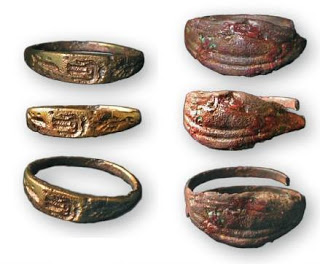Roman bronze coin was placed on a chest of a deceased. It was minted by the emperor Caracalla, in the early 3rd c. AD.
Apart from the ring and the coin, the grave also contained a bronze compasses. Ring and possibly compass are suggesting that person buried in this grave was important figure in early Christian community in Viminacium.
Just so people understand why the archaeologists are so excited about this find and why they believe it was a christian burial. Christian graffiti, fish, anchor and compasses, from the Catacombs of Saint Domitilla in Rome
Compass is sometimes used as a symbol of the Creation, and sometimes, especially in the Medieval period, God was shown with a compass in his hands, measuring the world that has just been created...For instance: The Frontispiece of Bible Moralisee, 13th c.
By the way, do you know that for measuring the heavenly dome you need compasses and for measuring the earth which lies underneath you need square? I talked about square and compasses, the tools of God, the Great Architect in this post...And about the origin of this symbol in Mesopotamia in this post...
Anyway, the discoveries from the last few years are showing that significant early Christian and Gnostic communities existed in the 2nd and 3rd c. AD in Viminacium, capital of Moesia Superior, a fortified Roman city which had around 30 000 inhabitants...
Site of Viminacium covers area of 450 hectares, and so far, only 2% have been excavated. Archaeologists say that there is enough material for the next 300 years of digging and exploration...
More than 14 000 graves and tombs with more than 30 000 interesting and valuable grave goods inside them have been found at Viminacium necropolis, which makes it the largest Roman cemetery in the world...
Unfortunately, most of Viminacium’s remains were found at the foot of a massive coal-fired power station and above the coal mine deposits, and archaeological excavations are hurriedly carried out before new units of the plant and intensive coal mining devastate this ancient site.
What these discoveries are proving is that Balkans was a centre of Early Christianity. When Serbian archaeologist Djordje Jankovic claimed the same thing years ago, he was ridiculed...But now his claims are being vindicated...
Jankovic based his claims on the discovery of these two 1st c. AD bronze rings, with engraved fish, good shepherd and palm branch!
These are the oldest christian rings found so far. They were found in Židovar, an archeological site near Vršac, Serbia. I talked about this in my post "Church on threshing floor"
Interestingly, Slavic legends claim that "Slavs were Christianised in the Balkans by St Paul".
Which places Christian Slavs in the Balkans in the 1st c. AD...I talked about this in my post "St Paul among the Slavs"...
So were there any Slavs among the Christians from Viminacium?






Regarding the first picture, I only saw a scale with balancing yin/yang fish, I thought not of a cross, but of the zodiac.
ReplyDeleteThe first picture looks like an anchor drawn by someone who had never seen an anchor, with the ring at the wrong end.
ReplyDelete